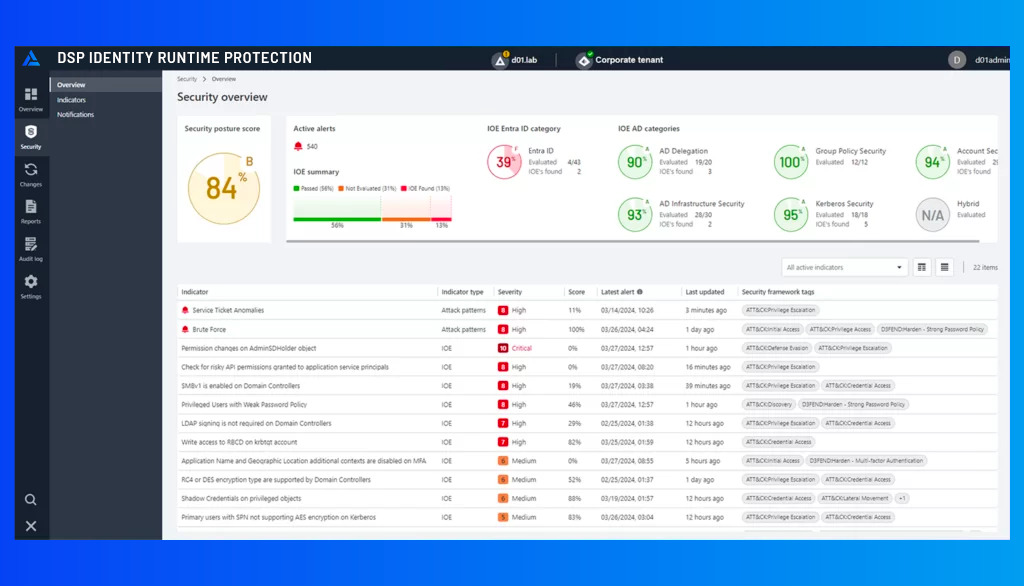
Directory Services Protector
Protect your critical identity infrastructure from cyberattacks with the industry’s most comprehensive identity threat detection and response (ITDR) platform for Active Directory and Entra ID.


Semperis Extends ML-Based Attack Detection with Specialized Identity Risk Focus
Identity Runtime Protection (IRP), the first offering in the Semperis Lightning™ platform, merges deep machine learning with unmatched identity security expertise to detect and stop the most successful attack techniques.
Learn moreComprehensive hybrid AD security
Securing Active Directory and Entra ID is hard. Misconfigurations accumulate over time, creating legacy security vulnerabilities that attackers love to exploit—in fact, 9 out of 10 cyberattacks involve AD, according to Mandiant researchers. Semperis provides the most comprehensive hybrid AD threat detection and response by continuously monitoring the environment, automatically rolling back malicious changes in on-premises AD and Entra ID and providing a single view of AD and Entra ID security posture.
Dial in your hybrid Active Directory security
Securing Active Directory is difficult because of its complexity and the proliferation of ransomware groups such as LockBit and Vice Society that target AD with new tactics, techniques, and procedures (TTPs). Directory Services Protector puts AD and Entra ID security on autopilot with continuous AD threat monitoring, real-time alerts, and autonomous remediation capabilities. DSP helps you respond more effectively to AD security incidents and everyday operational mistakes.
Vulnerability assessment
Continuously monitor AD and Entra ID for indicators of exposure (IOEs) and indicators of compromise (IOCs) that could result in hybrid identity system compromises. Use built-in threat intelligence from expert security researchers to uncover common misconfigurations such as expired passwords and trust accounts with old passwords.
Automated AD and Entra ID remediation
Automatically roll back malicious changes in on-prem AD and Entra ID. Create audit notifications on risky changes to sensitive AD and Entra ID objects and attributes. Auto-undo risky Entra ID changes in users, groups, and roles with custom rules and alerts.
Tamperproof tracking
Capture changes even if security logging off, logs are missing, agents are disabled or inoperable, or risky changes are injected directly into AD.
Entra ID change tracking
Use near real-time change tracking in DSP for Entra ID to monitor changes to role assignments, group memberships, and user attributes.
Compliance reports
Use pre-built compliance report templates that align with common compliance standards, including GDPR, HIPAA, PCI, and SOX.
Splunk integration
Bring detailed Active Directory security data—including Active Directory change data, DSP Security Indicator data, and DSP notification rule events—into familiar Splunk Enterprise views to provide meaningful context and visibility into vulnerabilities across your entire environment.
Microsoft Sentinel integration
Use new workbooks for Microsoft Sentinel that allow you to view additional data from DSP, such as Active Directory change data and DSP notification rule events, within Sentinel dashboards.
Delegation with RBAC
Use robust Role-Based Access Control (RBAC) and a rich web user interface to give AD administrators view-and-restore capabilities for their specific scope of control.
Is your Active Directory vulnerable to a cyberattack?
Active Directory is the primary identity service for 90% of businesses worldwide, providing user authentication and access to business-critical applications and services. An attack that wipes out AD (as in the 2017 NotPetya cyberattack on shipping giant Maersk) can disrupt business operations. Because of legacy misconfigurations and unpatched vulnerabilities, AD is a frequent target for attackers, including sophisticated ransomware groups such as LockBit and Vice Society. Mandiant researchers now estimate that 9 out of 10 attacks involve AD.
Frequently asked questions
Directory Services Protector (DSP) is a Gartner-recognized identity threat detection and response (ITDR) solution that puts hybrid Active Directory security on autopilot with continuous monitoring and unparalleled visibility across on-premises AD and Entra ID environments, tamperproof tracking, and automatic rollback of malicious changes.
In AD-based attacks, the only unalterable data source is the AD replication stream, which is outside the scope of any SIEM’s view. Additionally, most agent-based AD change auditing tools lack deep visibility to detect and thwart such attacks. The AD replication stream is the only reliable method of catching every change (pre-attack and during an attack), no matter how an attacker might attempt to cover their tracks. DSP integrates with any SIEM solution that consumes SYSLOG-formatted data. DSP further integrates with Microsoft Sentinel and Splunk. With Microsoft Sentinel, DSP provides workbooks that allow you to view additional DSP data within the Sentinel dashboard, such as Active Directory change data and notification rule events. The DSP Splunk Enterprise app provides detailed AD security data in the Splunk dashboard to provide additional context and visibility into vulnerabilities across the environment.
DSP provides continuous security vulnerability assessment across your on-prem and hybrid AD environment, scanning for hundreds of Indicators of Exposure (IOEs) and compromise (IOCs) across various categories of AD security, including account security, Group Policy, Kerberos, AD delegation, AD infrastructure, and Entra ID. DSP provides a dashboard of the overall security posture score, category scores, security indicators grouped by severity, and prioritized remediation guidance from AD security experts.
Yes, DSP offers rollback of malicious changes for both on-prem AD and Entra ID. DSP provides automated remediation of risky changes in on-prem AD and Entra ID to prevent attacks that move too fast for human intervention. DSP also supports granular rollback, allowing you to revert changes to individual attributes, group members, objects, and containers—and to any point in time, not just to a previous backup.
DSP is non-intrusive and built for compatibility with AD. This unique approach captures changes without compromising AD stability.
DSP is purpose-built for AD and can support even the most complex AD environments, including multi-organization and multi-forest deployments. Large and small organizations rely on Semperis to help them spot directory vulnerabilities, intercept cyberattacks in progress, and quickly recover from ransomware and other data integrity emergencies. With processing optimized for some of the largest organizations in the world, DSP can handle the large volume of daily and hourly changes that are common in massive AD environments.
Both Microsoft Defender for Identity (MDI) and Semperis solutions have critical roles in protecting identity systems from attack:
- MDI uses user-based analytics (UBA) to monitor and alert on user behaviors that fit into known user identity attack models.
- Semperis protects the entire hybrid AD service—the common attack vector in 90 percent of incidents—with patented technology purpose-built to prevent, mitigate, and recover from identity-based attacks.
Combining Semperis solutions with Microsoft Defender for Identity (MDI) provides a layered defense against attacks that exploit user identities and the AD identity service.
Directory Services Protector includes compliance report templates that align with common compliance standards, including GDPR, HIPAA, PCI, and SOX. You can import individual compliance bundles into DSP to support your organization’s needs. You also can schedule any DSP report, including compliance reports, for recurring generation and distribution.
The Directory Services Protector scoring method comprises various factors, including the potential consequences of an exploited vulnerability, ease of exploitation, and the overall prevalence. Based on these factors, each indicator is assigned a severity rating (level and number) that reflects the potential impact on security posture, availability, and performance. The severity rating is then used in the scoring formula to calculate the overall risk posed by the vulnerability.
DSP lets you add individual objects or conditions that are a known risk to an ignore list so they no longer trigger an alert in DSP or affect the overall security posture score. This approach helps you accurately assess risk and accelerate remediation.






















